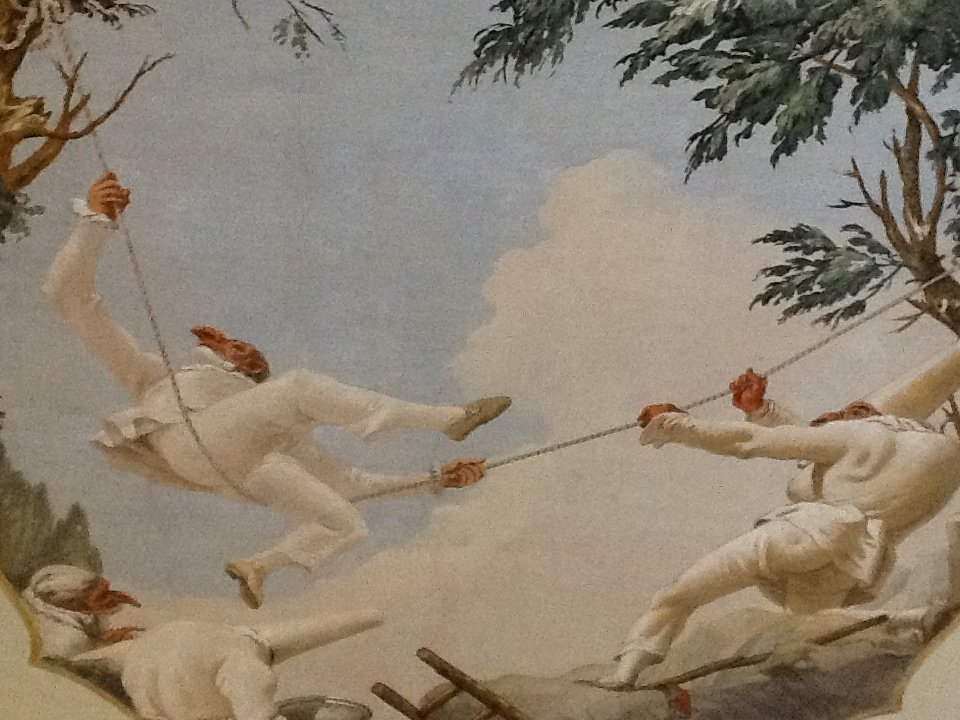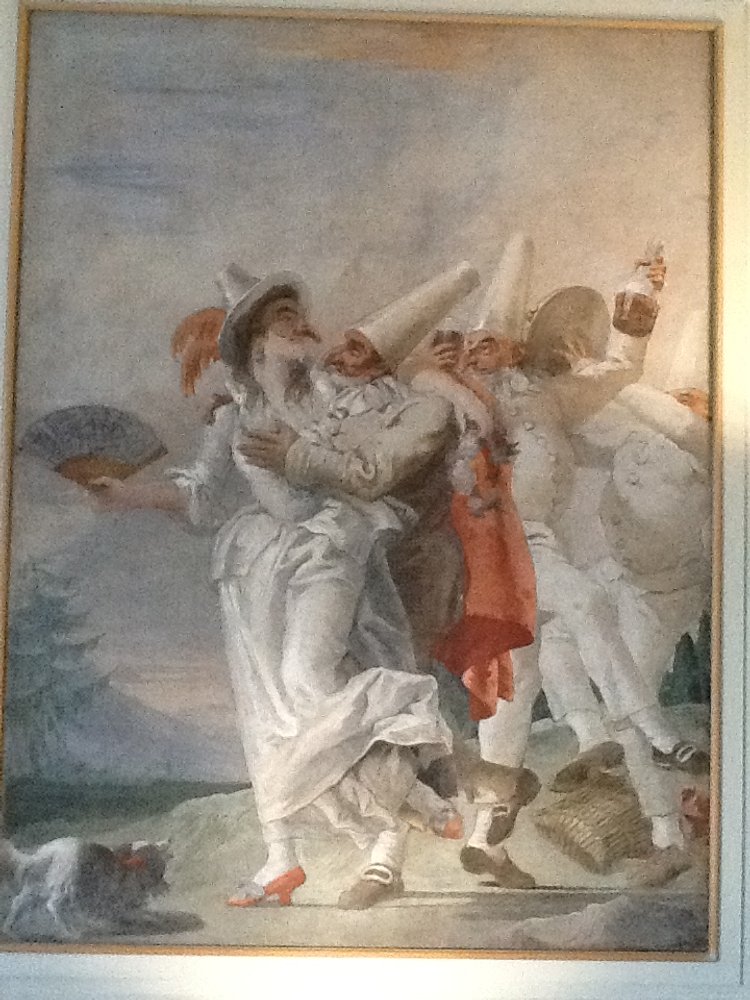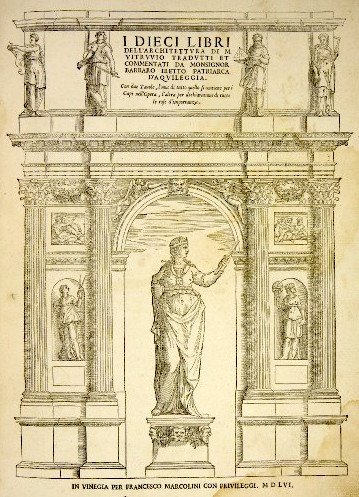Andrea Palladio (with scenographic modifications by Vincenzo Scamozzi), Teatro Olimpico, Vicenza, Italy, 1580–85 (photo: Terry Clinton, CC BY-NC 2.0)
Pratt in Venice studies the architecture of Andrea Palladio every year. In Venice, a day at San Giorgio Maggiore and Il Redentore, led by guest lecturer Prof. Tracy Cooper, is complemented by a full-day study trip in the Veneto to visit Palladio’s Villa Emo and Villa Maser.
In this guest essay, actor Ted Wilson muses on the Teatro Olimpico by Palladio in Vicenza and the Italian Commedia dell’Arte.
It has become clear to me that a great deal of what I thought I knew and understood about the Teatro Olimpico and the Commedia dell’Arte were filled with mythology, misunderstanding, and/or mistaken presumption. In some cases, someone (including me) was just making things up. No matter how I look at it, it seems that I have been living a lie – and perpetuating such misrepresentations for some 50 years. It is the objective of this presentation to set that record straight. Or at least as straight as more current research allows.
The premise of this presentation was to be a discussion of the challenges the Teatro Olimpico presented to the great companies that performed there during the heyday of the Commedia dell’Arte – that would be from 1585 when the first performance took place at the Teatro Olimpico, through about 1700, give or take a quarter century. Of course, the most academically astute will immediately realize the flaw in this thesis. There are no … zero, zilch, nada … extant records linking any Commedia companies to performances at the Teatro Olimpico. Moreover, it seems there is no evidence that any of the leading actors associated with the great troupes ever performed in anything at the Teatro Olimpico, either.
If I were to keep with the original premise of this paper, I would have to end here. Thank you very much for your applause; I’ll kick the dog and turn off the lights on my way out.
I might have expected such a monumental historical disconnect to create a walloping case of cognitive dissonance within every inch of my being. Yet, instead of abusing faithful pets, I smiled. Such a reaction in the face of the greatest intellectual train wreck of my life could be construed as psychosis. But, instead, I became determined to find out why the most popular theatrical entertainment of early modern Italy was never performed in arguably the most magnificent theatre ever constructed up to that time.
Despite stumbling upon several preliminary answers to that question, all of which had a bearing, my conclusion shocked me almost as much as the initial trauma that Commedia was never performed at the Teatro Olimpico. The fact of the matter is, the Teatro Olimpico never had a future as a professional performance space while the actors and troupes of the Commedia dell’Arte achieved the highest levels of professional achievement throughout its heyday. Another way of putting it is the Teatro Olimpico’s heyday was a fleeting moment in time while the Commedia dell’Arte was a tour de force for some 200 years or more.
I often began many presentations about the Commedia dell’Arte with a summary description similar to this:
Spanning three centuries, traveling troupes of Italian comic actors improvised their way from the tiniest piazzas in Italy, throughout Europe, and all the way into the French court, tickling the funny bones and capturing the imaginations of royalty and commoner alike.
Although this may be technically correct, like all summary statements, the devil is in the details. Unfortunately, this broad brushstroke reinforced certain presumptions and misunderstandings about the great companies of actors that collectively represented the Commedia dell’Arte from about the mid-16th to the early 18th centuries. It is not unusual for historical overviews of this Italian comedic tradition to present it primarily as street theatre, leaving the impression that, despite their prominence as the popular professional theatre of its time, the performers were something akin to street buskers. Yet, if we had the privilege to speak to any of the leading performers from that time period, they would not hesitate to offer a very different summary of their profession.
Giandomenico Tiepolo, frescoes of the Commedia dell’Arte originally from Villa Tiepolo in Zianígo, Italy, 1759–97, now in the collection of Ca’ Rezzonico, Venice (photos: Joseph Kopta)
If the troupes had remained little more than street performers, it would be no surprise that they would not have performed at the Teatro Olimpico. By the time the venue opened with its production of Oedipus Rex in 1585, however, the Commedia dell’Arte was already well on its way as a popular and established professional entertainment. As such, the transition from its various roots and influences as a predominantly street entertainment to professional entity had already taken place. The most popular and well-established companies were spending more performance time at indoor venues than on makeshift stages outdoors. It appears quite possible that some of the extant reports from those who witnessed outdoor street performances may have been seeing promotional presentations rather than full-scale productions. What has become clear, however, is that the better troupes preferred the convenience and economic control of indoor venues where weather would not be a factor, special effects and scenic elements were more effective, and they could ensure entry fees would be collected without the hit-or-miss of “passing the hat.”
Commedia dell’Arte was more than just improvisational comedic performances whether indoors or out. The great troupes along with their very best performers were in demand for a variety of theatrical performances including scripted dramas, pastorals, and musical entertainments. Like public, private, and corporate support of modern theaters, today, ticket sales, alone, could not support the professional needs of a troupe. Whether it was Italian nobility, aristocratic families, or the royal patronage of the French court, major troupes needed what we think of in our contemporary times as both earned and contributed income to survive. It is almost impossible to imagine today’s professional performers passing a hat after a performance, yet that is the perception that is often presumed of the celebrated professionals of the Commedia dell’Arte.
In both Italian and European history, developments of the Renaissance accelerated the economy of the Middle Ages and led to a spread of wealth that characterized the early modern period. With enough savvy and talent, people of humble heritage were able to climb the economic ladder, enabling them entry to a few previously aristocrat-only circles. One such circle was the Accademia Olimpica in Vicenza.
Through the Middle Ages and Renaissance, Vicenza’s socio-political structure was a bit different from most of its nearby towns. Where deep ancestral roots yielded single-family aristocracies, Vicenza had an equally long history of shared leadership and influence by a tightly knit, birds-of-a-feather group of noble families. But that almost subconscious orientation to power sharing – it would be a mistake to think of it as “democratic” – would show itself in another way of particular significance to the subject at hand.
The Piazza dei Signori, Vicenza, with the Basilica Palladiana designed by Palladio at right beginning 1549. (photo: barnyz, CC BY-NC-ND 2.0)
It might be fashionable to vilify the concentration of wealth and power of the nobility, but without their patronage, the arts – including most of the major troupes of the Commedia dell’Arte – might have floundered in obscurity and the Renaissance may never have happened at all. Vicenza, having no single family attached to their identity, went a different way.
It may be no coincidence that while professional troupes were being established in the middle of the 16th century, other related activities were emerging. The rise of non-university, non-religious associations dedicated to social, intellectual, or cultural activities began in Tuscany during the 15th century. The idea eventually spread throughout the Peninsula and Europe, and Vicenza was no exception. By the time we get about halfway through the 1500s, developments that characterized the Renaissance opened the doors for people below the aristocratic classes to rise into leadership positions within Vicenza’s social fabric. In 1555, although inclusive of but independent of noble influence, a disparate group of scholars, writers, artists and other intellectuals came together to create the Accademia Olimpica. The organization would be committed to cultivating all the arts in Vicenza. Among the founding members was the son of a miller who would become the famed architect, Andrea Palladio.
Palladio had been planning and researching ancient Roman architecture including theatres for decades prior to the Teatro Olimpico. Guided by the Renaissance ideals of classical influence over art and architecture, his designs were steeped in ancient Roman and Greek principles. As he approached the end of his long and productive life, his desire to design a classical theatre was an itch he desperately wanted to scratch. He had already built a wooden theatre inside a basilica based on Roman theatres. As a member of the Accademia Olimpico, it would appear that everyone turned a blind eye to Palladio’s conflict of interest when they decided it was time to build a permanent theatre at his urging … and that Palladio was just the guy to get it done. It took little time for the city of Vicenza to approve the project and for Palladio to begin building it.
Title page, Marcus Pollio Vitruvius, Ten Books on Architecture, translated and with commentary, illustrations by Andrea Palladio (published in Venice by Francesco Marconi da Forli, 1556)
As was Palladio’s style going into any project, he had broad concepts and basic drawings, but many details would merely be bridges to cross when he got to them. The Teatro Olimpico was no exception. It would be the last thing he ever designed. He began work on it in 1580 but died soon after. The next generation of architects would take over in the person of Vincenzo Scamozzi. Thus, there is a split within the continuity of the Teatro Olimpico: that which was designed and intended by Palladio and that which was designed and implemented by Scamozzi.
Palladio’s design is almost a Klein bottle theater in which everything is both inside and outside. He designed into it all the elements of an exterior portico or scena frons (as in the Roman theater in Verona) as well as the amphitheater structure of an ancient Roman arena. Most likely influencing the Accademia’s decision are the 80 statues surrounding the audience and each side of the stage. Like plaques listing the major donors of modern cultural institutions, each of those statues was of a member of the Accademia. If the grandeur of the space wasn’t enough, all those statues forever looking over an audience’s shoulders added to the inherent distractions.
The façade of the Villa Emo by Palladio, Fanzolo, Italy, with portico at center (photo: Joseph Kopta).
Teatro Romano, an ancient Roman theatre in nearby Verona, 1st century BCE (photo: Diana Gisolfi)
The magnificence of the place feels overwhelming. It is, in and of itself, a magnificent work of art. While the theatre’s architecture as art became the attraction instead of the normal presentation of theatrical art, Scamozzi’s set steals the scene. Palladio’s intent was that the initial performance was to be a pastoral and although there are no extant designs of his intent, it is known that he intended to make some use of perspective for the set. Upon his death, however, this intent was never realized. Instead, the opening show would be Oedipus Rex – a heavy tragedy instead of some lighter fare. The Accademia believed that the Teatro Olimpico was the epitome of contemporary desires that defined the Renaissance: the perfect expression of ancient architecture. To go along with it, then, they believed that Oedipus Rex was the perfect expression of ancient theatrical literature. Scamozzi, for his part, had his own ideas – for the theatre and for the set.
Columnated portico with the members of the Accademia as classically-inspired sculptures. Andrea Palladio (with modifications by Vincenzo Scamozzi), Teatro Olimpico, Vicenza, Italy, 1580-85 (photo: Neil, CC BY-NC-ND 2.0)
Oedipus Rex takes place in Thebes and Scamozzi’s set is supposed to represent the streets of Thebes. However, in its execution, he uses buildings and scenes from what was 16th century “modern day” Vicenza. If that duplicity wasn’t enough, he adds insult to injury with the most egregious scene stealer ever to be built into a theatre. The best seats in the house are those that look straight up the center street scene and those eyes are taken up that street and away – away from Thebes, away from Vicenza, away from Palladio, and, indeed, away from the Teatro Olimpico, itself.
When I walked into the Teatro Olimpico during my all too brief visit in 2001, the front of the stage was filled with scaffolding as renovations were taking place. Sitting in the best seats in the house were another couple from our tour. The space was all too familiar to me and I was excited to see Palladio’s jewel up close and personal. The other couple, probably noting my pointing and gawking at this feature or that, turned to me and asked, “What is this place?” My wife took a seat; she knew what was about to happen. Although my presentation was filled with the misinformation that I had been filled with in my early studies of the Commedia dell’Arte and its mythical role with the Teatro Olimpico, twenty minutes later I focused my audience of two on that center street scene. I told them about one-point perspective and how all the lines of the set converged at that one point. Despite the scaffolding, I knew precisely where that point was and saw that it was still rather apparent. I guided their eyes upward from the base of the stage, I knew when they reached that point of convergence. Both involuntarily gasped, “Wow!” Yes, they were impressed with Palladio’s masterpiece, but the tipping point was not the theatre nor was it Scamozzi’s set design, per se. That infinite vanishing point of one-point perspective stole the scene. Indeed, it stole the entire theatre.
Perspectival scenography of the stage, Andrea Palladio (with modifications by Vincenzo Scamozzi), Teatro Olimpico, Vicenza, Italy, 1580-85 (photo: Patrick Denker, CC BY 2.0)
It is a matter of some scholarly debate as to whether Scamozzi took Palladio’s masterpiece to greater heights or if that set design with its one-point perspective undermined, or was, Palladio’s intent. A case can be made both ways. But I find it interesting that in most of the general literature I have read about theatre design and architecture, the Teatro Olimpico belongs to Palladio with Scamozzi mentioned almost in passing. It is only the most targeted literature that gives Scamozzi his due, whether that is perceived as good or bad.
Extant documents from the time suggest that the Accademia wasted little time to protect its masterpiece. The Teatro Olimpico was not only viewed as a theatre, but also as a precious work of architectural art. In their collective minds, like any work of art, it had to be safeguarded. The fact that it was a complete theatre – both “outside” and inside – that was built inside another building was not lost on them. It made it almost akin to a modern-day installation. Programing, therefore, had to be done lightly. It would be used sparingly, only for formal receptions and other occasional ceremonial activities.
It seems to be generally agreed that the Teatro Olimpico achieved the Accademia’s desire; it has survived the ages because of its lack of use. Because of the use of candle and oil light for both house and scenic lighting effects, fire was the most common cause of a theatre’s demise. The Teatro’s limited use minimized that risk.
Sectional drawing of the Teatro Olimpico by Ottavio Bertotti Scamozzi, 1776, with Scamozzi’s one-point-perspective vanishing point at left and seating at right
In addition, as beautiful as it was, it was the epitome of an ancient design in the clothing of the day. Indeed, its virtue and its intent were to express ancient theatrical architecture in a contemporary building. But that notwithstanding, although it conveyed what made the Renaissance the Renaissance, it was a theatre looking backward and not forward. And that was not lost on the theatre community. If its use was being kept in short supply by the Accademia, demand was equally muted by theatre companies. Well-balanced economies can last quite a long time and the Teatro Olimpico, it would appear, maintained such a balance for 200 years and more.
Thus, even though Commedia dell’Arte companies found purpose-built theatres and other suitable indoor spaces to be their usual choice for performances, the Teatro Olimpico was most likely low on their list. There were other venues without all the queasiness of the landlord (i.e., the Accademia Olimpica) looking nervously over their shoulders to make sure the work of art would in no way be marred.
Thus, this great divergence cited in the title of this presentation. The Commedia and its troupes would go its way, reaching celebrated peaks of popularity throughout Europe over the next century and half. Going in almost the opposite direction over that same time, the Teatro Olimpico, under the protection and restrictions of the Accademia Olimpica, would become almost forgotten in its obscure corner of Vicenza. Indeed, Arlecchino would not be making an entrance climbing over the shoulder of one of the founder’s statues.
Andrea Palladio (with modifications by Vincenzo Scamozzi), Teatro Olimpico, Vicenza, Italy, 1580–85 (photo: philip-brown, CC BY-ND 2.0).
Selected Resources
The Classic Theatre (Volume One: Six Italian Plays), edited by Eric Bentley
The Commedia Dell'arte: A Documentary History, Kenneth Richards, Laura Elizabeth Richards
The Italian Comedy, Pierre Louis Duchartre
Lazzi: The Comic Routines of the Commedia dell'Arte, Mel Gordon
Oxford Bibliographies: Renaissance and Reformation – Academies, Simone Testa
Personal email exchange with Dr. Franklin J. Hildy, Professor, School of Theatre, Dance, and Performance Studies, University of Maryland
A Source Book in Theatrical History, A.M. Nagler
The Teatro Olimpico Guide, Maria Elisa Avagnina
The Teatro Olimpico in Vicenza, Fernando Rigon
The Routledge Companion to Commedia dell'Arte, edited by Judith Chaffee & Oliver Crick
Theatre Symposium: Commedia Dell'Arte Performance: Contexts and Contents, a Journal of the Southeastern Theatre Conference, Vol. 1
The Tricks of the Trade, Dario Fo
Palladio, James Ackerman
How a person with 100% Italian heritage ended up with the last name of Wilson is a story as convoluted as his biography. There is not room for both, here, so we’ll stick with the bio.
Photo courtesy Ted Wilson
Ted Wilson has taken the scenic route through life. With an aversion to long-term professional commitments, among other pursuits and not necessarily in any particular order, he has been a short order cook, a stockbroker, a writer, a counselor and therapist, a conference consultant, a retail electronics salesperson, a trade-show booth designer, a marketing director (twice), a substitute teacher (with a blood-stained white shirt to prove it), a development director, a health insurance salesman, and a funeral pre-planning salesman. He once presented this list to a group and someone quipped, “He can’t hold a job!” That was closer to the truth than he cared to admit. He ultimately found his true calling as a bartender and classic cocktail mixologist, which led to the publication of his book, Guerrilla Cocktails: One man’s quest for a damn fine drink in his own neck of the woods.
On his way to a degree in Theatre and Psychology from the University of Delaware, Ted eventually accumulated a great deal of study in theatre movement, improvisation, and mask-making with a special emphasis on the Commedia dell’Arte. He has worked as an actor, director, writer, teacher, juggler, and mask maker in community, educational, and professional settings. Ted also has a long history of community arts management in both performing and visual arts settings. Ted has been a part of founding and performing in three small theatre troupes, all of which focused on improvisation, especially featuring Commedia dell’Arte. He has written, adapted, directed, and/or performed in a number of Commedia-inspired productions. Beyond his Commedia work, other improvisational work included a stint with a comedy improv troupe in Wilmington, DE. Other acting credits have included Boss Finley in Sweet Bird of Youth, Sorin in The Seagull, Lennie in Doubles, and he was featured as Mr. Bernstein in the children's film Drawing a Blank, which was shown exclusively on Nickelodeon.
Retirement has made up for any shortcomings he had in all those jobs. As he leisurely strolls into his dotage, he and his wife of 48 years, Ann, enjoy reading, birding, hiking, traveling, fine dining, and a cocktail or two every now and then. His life-long quest to learn the Italian language continues to sit slightly out of reach.









